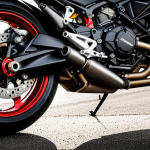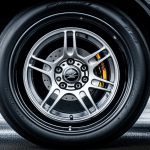Identifying Clutch Plate Wear on the Suzuki Hayabusa
Recognizing Suzuki Hayabusa clutch wear early is essential for smooth motorcycle maintenance. The most common clutch plate symptoms include a slipping clutch where engine revs increase without a corresponding rise in speed, difficulty shifting gears, and a spongy or dragging clutch lever feel. These signs point directly to worn clutch plates needing attention.
The effects of clutch plate wear on Hayabusa performance are significant. A worn clutch can cause loss of power transfer, resulting in sluggish acceleration and increased engine strain. This not only diminishes ride quality but may lead to further drivetrain damage if ignored.
Cela peut vous intéresser : Master DIY Tutorial: Expert Tips for Replacing Your Kawasaki Ninja 400 Rear Shock Absorber like a Pro!
Distinguishing clutch wear from other transmission issues can be tricky. Clutch-specific problems typically manifest during gear engagement or disengagement, unlike gearbox faults which usually cause noise or grinding. Testing for consistent clutch slippage under acceleration helps isolate the issue clearly.
Understanding and identifying these symptoms accurately allows riders to take timely action, preserving the Hayabusa’s renowned performance and reliability while avoiding costly repairs later.
A découvrir également : Complete DIY Manual: Expert Tips for Replacing Rear Brake Pads on Your Ducati Streetfighter V4!
Causes and Contributing Factors to Clutch Plate Wear
Understanding the causes of clutch plate wear is crucial for effective motorcycle maintenance on the Suzuki Hayabusa. One major factor is aggressive riding style—rapid acceleration, frequent clutch slipping, and unnecessary clutch holding increase friction, accelerating wear. Additionally, long periods spent in stop-and-go traffic can overheat the clutch plates, reducing their lifespan.
Hayabusa-specific issues also contribute. Its high-performance engine delivers significant torque, meaning the clutch plates endure greater stress compared to average motorcycles. Mechanical factors, such as improper clutch cable adjustment or using low-quality clutch fluid, can hasten wear, compromising clutch responsiveness.
Neglected maintenance further worsens the situation. Failure to routinely check for clutch plate tolerances or delays in fluid changes often lead to premature degradation. Owners should be aware that improper installation during previous repairs or aftermarket part substitutions might also affect clutch durability.
By recognizing these causes, riders can adjust motorcycle riding habits and maintenance routines to mitigate Suzuki Hayabusa clutch wear, ensuring a longer clutch lifespan and consistent performance.
Step-by-Step Inspection Guide for Hayabusa Clutch Plates
Careful clutch plate inspection is key to maintaining your Suzuki Hayabusa’s performance. Begin by gathering essential tools: a torque wrench, feeler gauges, screwdrivers, and clean rags. Always disconnect the battery and ensure the bike is stable on a stand before starting to avoid accidents during inspection.
To access the clutch plates, remove the clutch cover by loosening bolts systematically. Keep track of washers and springs; Hayabusa-specific parts require careful handling to prevent damage. Once exposed, visually inspect the clutch pack for discoloration, warping, or excessive wear on friction and steel plates.
Measure the thickness of each friction plate against Suzuki’s specified tolerances, generally around 2.0 mm minimum thickness. Plates thinner than this indicate significant wear and need replacement. Also, check for signs of oil contamination or glazing, as these affect clutch grip and lifespan.
Ensure even wear across plates; uneven wear patterns often signal riding habits that stress the clutch or incorrect installation. Following a regular Hayabusa maintenance guide including these inspection steps helps detect problems early, ensuring reliability and optimal clutch performance without surprises on the road.
Maintenance and Care Best Practices
Suzuki Hayabusa clutch maintenance demands consistent attention to prolong clutch lifespan. Regularly checking and adjusting the clutch cable tension prevents excessive slippage, a key clutch plate symptom indicating wear. Follow the Hayabusa care routines recommended by Suzuki, typically involving fluid changes every 12,000 km or sooner if riding conditions are harsh. Using high-quality clutch fluid maintains hydraulic pressure stability, protecting internal components.
Routine lubrication of moving parts such as the clutch lever pivot enhances responsiveness and reduces mechanical strain. Ignoring these steps accelerates clutch wear, affecting overall motorcycle maintenance goals. Cleaning clutch components carefully to avoid contamination supports optimal grip between friction plates and steel plates.
Adhering to scheduled inspections within the Hayabusa maintenance guide enables early detection of emerging clutch issues. In practice, riders should also modify riding habits that induce unnecessary clutch stress, like prolonged slipping or abrupt engagement. Employing genuine Suzuki parts during maintenance ensures proper fit and durability.
Implementing these clutch maintenance tips combines practical adjustments with methodical care, fostering reliable performance and extending clutch service intervals on your Suzuki Hayabusa.
Clutch Plate Replacement Process for Suzuki Hayabusa
Replacing worn clutch plates on your Suzuki Hayabusa requires careful preparation to ensure a successful repair. Begin by securing a clean, well-lit workspace with organized tools, including a torque wrench, screwdrivers, and clutch alignment tools. Disconnect the battery and stabilize the bike on a stand to prevent accidents during disassembly.
To access the clutch pack, remove the clutch cover bolts evenly to avoid warping. Carefully extract the pressure plate, clutch springs, and worn friction and steel plates. Note the order and orientation of parts to guarantee correct reassembly. Compare the thickness of removed friction plates against Suzuki’s specified minimum; replace all worn clutch plates with genuine Suzuki parts for durability.
Before installation, clean the clutch basket and inspect for damage. Soak new friction plates in fresh engine oil as per the Hayabusa maintenance guide to ensure proper function. Reassemble components in reverse order, tightening bolts with a torque wrench to manufacturer specs to avoid leaks or damage.
Proper execution of this Suzuki Hayabusa clutch replacement process restores clutch performance and ensures reliable power transfer, preventing future slippage and wear.






